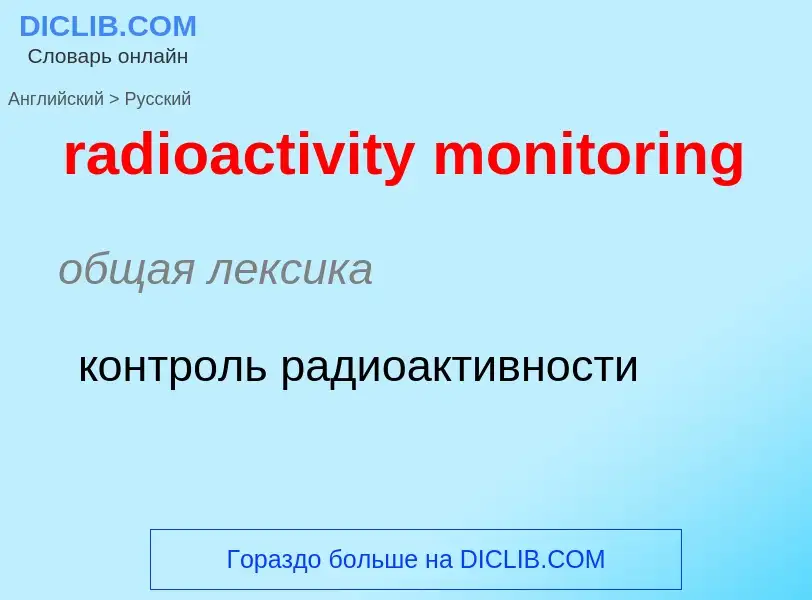Tradução e análise de palavras por inteligência artificial ChatGPT
Nesta página você pode obter uma análise detalhada de uma palavra ou frase, produzida usando a melhor tecnologia de inteligência artificial até o momento:
- como a palavra é usada
- frequência de uso
- é usado com mais frequência na fala oral ou escrita
- opções de tradução de palavras
- exemplos de uso (várias frases com tradução)
- etimologia
radioactivity monitoring - tradução para russo
общая лексика
контроль радиоактивности
['mɔnit(ə)riŋ]
общая лексика
регистрация функций организма с сигнализацией об отклонениях от нормы
мониторинг
перманентный контроль
слежение (напр. за состоянием среды)
дозиметрический контроль
дозировка
слежение, контроль, мониторинг
контролирование
контролирующий
контроль
контроль подслушиванием
контрольно-выпрямительный
контрольный
коррекция гироскопа
подслушивание
проверка
управление
управляющий
медицина
дозиметрия
мониторное наблюдение
наблюдение
мониторирование
регулирование
строительное дело
контроль, мониторинг (непрерывное наблюдение переменной)
дистанционный диспетчерский контроль
нефтегазовая промышленность
текущий контроль
Смотрите также
существительное
общая лексика
контроль
подслушивание
радиоперехват
физика
дозировка
дозиметрический контроль
Definição
Wikipédia
Induced radioactivity, also called artificial radioactivity or man-made radioactivity, is the process of using radiation to make a previously stable material radioactive. The husband and wife team of Irène Joliot-Curie and Frédéric Joliot-Curie discovered induced radioactivity in 1934, and they shared the 1935 Nobel Prize in Chemistry for this discovery.
Irène Curie began her research with her parents, Marie Curie and Pierre Curie, studying the natural radioactivity found in radioactive isotopes. Irene branched off from the Curies to study turning stable isotopes into radioactive isotopes by bombarding the stable material with alpha particles (denoted α). The Joliot-Curies showed that when lighter elements, such as boron and aluminium, were bombarded with α-particles, the lighter elements continued to emit radiation even after the α−source was removed. They showed that this radiation consisted of particles carrying one unit positive charge with mass equal to that of an electron, now known as a positron.
Neutron activation is the main form of induced radioactivity. It occurs when an atomic nucleus captures one or more free neutrons. This new, heavier isotope may be either stable or unstable (radioactive), depending on the chemical element involved. Because neutrons disintegrate within minutes outside of an atomic nucleus, free neutrons can be obtained only from nuclear decay, nuclear reaction, and high-energy interaction, such as cosmic radiation or particle accelerator emissions. Neutrons that have been slowed through a neutron moderator (thermal neutrons) are more likely to be captured by nuclei than fast neutrons.
A less common form of induced radioactivity results from removing a neutron by photodisintegration. In this reaction, a high energy photon (a gamma ray) strikes a nucleus with an energy greater than the binding energy of the nucleus, which releases a neutron. This reaction has a minimum cutoff of 2 MeV (for deuterium) and around 10 MeV for most heavy nuclei. Many radionuclides do not produce gamma rays with energy high enough to induce this reaction. The isotopes used in food irradiation (cobalt-60, caesium-137) both have energy peaks below this cutoff and thus cannot induce radioactivity in the food.
The conditions inside certain types of nuclear reactors with high neutron flux can induce radioactivity. The components in those reactors may become highly radioactive from the radiation to which they are exposed. Induced radioactivity increases the amount of nuclear waste that must eventually be disposed, but it is not referred to as radioactive contamination unless it is uncontrolled.
Further research originally done by Irene and Frederic Joliot-Curie has led to modern techniques to treat various types of cancers.

